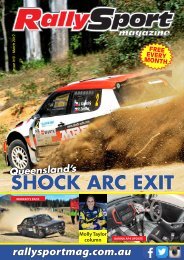RallySport Magazine September 2016
The September issue of RallySport Magazine features the latest rallying news form Australia and New Zealand, including coverage of the World Rally Championship.
The September issue of RallySport Magazine features the latest rallying news form Australia and New Zealand, including coverage of the World Rally Championship.
You also want an ePaper? Increase the reach of your titles
YUMPU automatically turns print PDFs into web optimized ePapers that Google loves.
RETROSPECTIVE<br />
bounce up and down – I think he was<br />
Irish!<br />
Well, all these bouncing shenanigans<br />
used to go on every time a boggy<br />
lane or a slippery creek crossing was<br />
encountered, and in those days that<br />
was fairly regularly. It wasn’t always the<br />
end of the world when you got bogged;<br />
in fact, it was often good fun being able<br />
to get out of the car for some exercise<br />
after having your head down over the<br />
maps for hours, even days, on end.<br />
Trouble was, once you’d done the<br />
bouncing bit and the car was<br />
actually moving forward again,<br />
you’d step off the jump bar into the<br />
boggy wheel ruts that the car had just<br />
dug or, even worse, you’d get sprayed<br />
with thick, black (or red, or grey, or<br />
yellow – delete whichever doesn’t apply)<br />
mud as the driver gunned the motor for<br />
more traction.<br />
It wasn’t unknown for drivers to really<br />
plant the foot and hightail it to dry,<br />
solid ground where traction wasn’t a<br />
problem, before stopping to wait for<br />
the navigator to rejoin him.<br />
Fair enough, you might say, but in<br />
the middle of winter the nearest high<br />
ground might be a mile away, and<br />
by the time you got to the waiting<br />
car after walking through thick mud,<br />
running water and slippery grass for<br />
what seemed like hours, you’d look like<br />
something out of Creature from the<br />
Black Lagoon.<br />
“Get in, get in,” he’d roar and so you’d<br />
climb aboard. Then, just as you were<br />
about to shut the door and belt up,<br />
you’d realise that under that thick layer<br />
of mud covering your feet, your left<br />
shoe was missing, obviously left behind<br />
60 | RALLYSPORT MAGAZINE - SEPTEMBER <strong>2016</strong><br />
“The problems arose<br />
when Murphy’s Law<br />
intervened and you<br />
became stuck in an<br />
area that resembeled<br />
the Treeless Desert on<br />
the Nullabor.”<br />
in that sticky black morass stretching<br />
out behind you. What to do? Waste<br />
more time going back to look for it (and<br />
risk losing the right shoe as well), or<br />
continue on with a limp like a man with<br />
an artificial leg? Ah, those were the fun<br />
days!<br />
Competitors in early trials like<br />
the infamous BP Rally and other<br />
navigational nightmares got so used<br />
to getting bogged that it got to the<br />
stage where crews used to take half a<br />
ton of de-bogging gear with them in<br />
each event. Not only was the jump bar<br />
compulsory equipment, there were<br />
other aids that were often carried as<br />
well.<br />
Forget wet weather compounds<br />
and special tyre cuts, the serious<br />
competitor always carried two spare<br />
wheels in the boot, already kitted out<br />
with a set of chains in case the going<br />
got really tough. At the first sight of<br />
mud or potentially impassable creek<br />
crossings, it was out with the jack, off<br />
with the Dunlop SP44s or the Goodyear<br />
Ultragrips, and on with the chains.<br />
Boy, did chains work in the mud!<br />
Great for getting you out of sticky<br />
Being bogged is bad<br />
enough, but when the tow<br />
car gets bogged too, you<br />
really have problems!<br />
situations and yep, you guessed it,<br />
the navigator was the one who had<br />
to remove them when dry ground<br />
appeared on the horizon! Sections<br />
timed to the second? Forget it! Just<br />
getting to the next control the same day<br />
was an achievement!<br />
However, if all that failed and you<br />
were stuck fast like a bug on the<br />
windscreen, the last resort was always<br />
the Tirfor. What’s that, you say? What’s<br />
a Tirfor? A Tirfor, dear friends, was a<br />
particular brand of winch that every<br />
serious trials competitor carried in<br />
the boot of the car. It never saw the<br />
light of day until all other methods of<br />
extraction had been exhausted, but it<br />
was invaluable if you were hopelessly<br />
bogged.<br />
Like most other forms of winch, you<br />
attached one end of the cable to the<br />
car and the other end to a tree, which<br />
was all well and good if you were stuck<br />
in a suitably-treed laneway or paddock.<br />
The problems arose when Murphy’s<br />
Law intervened and you became stuck<br />
in an area that resembled the famous<br />
Treeless Desert on the Nullarbor. No<br />
trees, no winching point.<br />
Of course if there was a convenient<br />
fence post handy, you could always<br />
winch off that. Problem was, if the fence<br />
post was old and rotten, you could end<br />
up with a corner post, a strainer post, a<br />
couple of hundred droppers and four<br />
kilometres of barbed wire on the end of<br />
your Tirfor.<br />
The other problem was that if you<br />
found a tree to winch from, everything<br />
would be going along smoothly for<br />
a while. Then, just as you got a nice<br />
backward-forward rhythm going on















